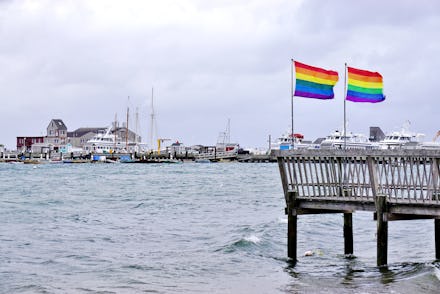A brief history of the gayest places in America — and how they came to be

As a month of international Pride draws to a close, let’s consider for a second the places that proudly fly the rainbow flag year-round, long after the parade confetti has been cleaned up off the streets. From the edge of New England to the recesses of the California desert, America has a constellation of destinations for the queer community, all of which came into being well before it was considered socially acceptable to be out and proud.
In a world where prejudice is (ideally) melting away, and global travel is on the rise, will these strongholds remain gay havens? And, most importantly, we’re wondering the same thing that 10% of the world’s mothers want to know: “How did you end up so gay in the first place?”
The easy answer is geography. Holiday favorites like Provincetown, Massachusetts, and Key West, Florida, are, quite literally, at the end of the world: ‘P-Town’ is curled up at the tip of Cape Cod’s cat tail, and, as the name suggests, Florida’s westernmost isle is at the edge of the archipelago.
“It’s difficult to grasp, especially for young LGBT people in major Western metropolises, but it wasn’t easy to travel openly until very recently,” Ed Salvato, co-author of the Handbook of LGBT Tourism and Hospitality, said in an interview. “Queer vacationers would seek difficult-to-reach destinations—protected places where you could feel comfortable being 100% yourself,” Salvato explained. “Until recent years Key West wasn’t even connected to the mainland by a bridge. The only way to access the island was by boat or plane. It was remote, hard to get to, and beautiful, attracting all sorts of misfits, libertarian-leaning citizens and gays.”
Beyond physical locations, “LGBT meccas also have a common origin story in the arts,” Matthew Breen, editorial director at Logo, said. “Tennessee Williams was in Key West, artists took over P-Town a hundred years ago after the fishing was decimated and Palm Springs was the Hollywood getaway.”
“LGBT meccas also have a common origin story in the arts,” — Matthew Breen, editorial director at Logo
Jim Suguitan, the former co-owner and editor of Palm Springs’ erstwhile gay publication the Bottom Line, remembers when the city started building a loyal following beyond regional gay visitors hoping to club-hop under the radar. Suguitan moved to the area in the 1980s and credits the Desert Business Association (originally the Desert Businessmen’s Association) and its co-founder Fred Hardt with transforming Palm Springs into an international gay mecca by positioning it as a worthy alternative to the beach. “Fred Hardt was quite the character,” Suguitan said. “He would stand by his mailbox on Indian Canyon Drive and would let people cruise him, and when AIDS reared its ugly head he turned his hotel into a hospice.”
And while the desert sand of Palm Springs was the playground for closeted stars and starlets, the isolated beaches of Fire Island hosted New York City’s wealthy gays. In an email interview, Shoshanna McCollum, Fire Island resident and author of Fire Island: Beach Resort and National Seashore noted the inception of the gay presence in the area, citing what may be the first documented instance of the almighty DINK (double income no kids) dollar: “The Great Depression and the Hurricane of ’38 devastated the community [of Cherry Grove]. It rebounded because the gay sector came along with their disposable income to invest at a time when there was little spare money to be had.”
Almost a hundred years later, Fire Island still retains its moneyed reputation, being the preferred hideaway to one of the world’s financial capitals. “It can be intimidating since it’s very ‘A-List’” Salvato said. “It’s much less democratic than other LGBT destinations — a weekend in Fire Island at a friend’s place is a coveted invitation.”
While most queer holiday spots neatly fall into either the ‘enclave’ or ‘end-of-the-world’ categories, there’s one perennial destination that doesn’t fit the mold: Disney World. Eddie Shapiro, co-author of Queens in the Kingdom likens the park’s popularity to the intangible idolatry of Judy Garland, but has a few theories as to why the so-called ‘happiest place on earth’ is pretty darn gay too. “In the worst cliches of what gays like — musical theatre and spectacles — Disney is a land of escapism. I think the gay community really identifies with the Disney characters; they’re frequently the underdog and they triumph in spite of the people around them.”
But, as Shapiro explains, Disney’s embrace of the LGBT-ers didn’t start from within the castle walls. “There was a man, Doug Swallow — I swear you can’t make this stuff up — who, as a fan of the park, wanted to show up and mix in with the hetero crowd. The word was spread by AOL messenger, and everyone was to wear a red shirt to be identified by one another.” Disney’s attitudes toward what became known as GayDays has greatly evolved over the last 27 years, from posting signs outside warning people about influx of LGBT park-goers to embracing GayDays outright.
Today, Walt Disney World’s president is an openly gay man, and devotion from the community is, as Shapiro explains, “so deep in the consciousness now that it’s popular with gays every other day of the year too.”
Palm Springs, too, has an openly gay mayor, and — according to Suguitan — a population that’s 60% gay year-round.
When looking toward the future, Breen is confident that these LGBT destinations will continue to thrive even as equality becomes more widespread. “98% of the world is made up of straight destinations, I would be surprised if we gave all of that up. The modern gay traveler may choose to beat their own trail, but the default setting is always straight — it’s fun to escape to an all-queer environment.”
“I, for one, love it,” he added. “I will always continue to go.”